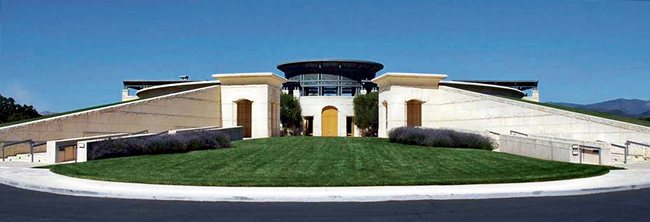Opus One Tops California First Growths
Napa Valley Cabernets have and always will be compared to Bordeaux wines in terms of price, grandeur and, less fairly, in style and flavor. While having lunch with some wine and restaurant leaders recently, the subject, or perhaps more accurately, a debate, of creating a list of California “First Growths” began. As I have had this conversation on several occasions with different groups, I felt that I had much to share on the subject.
 [/media-credit]
[/media-credit]Opus One Winery in California’s wine country is partly owned by the Baroness Philippine de Rothschild
One must first be reminded that the Bordeaux Classification and status given to the first Five Growths, of which four were from the Medoc (Chateaux Margaux, Lafite-Rothschild, Latour and Mouton-Rothschild), and the one and only from the Graves district (Chateau Haut-Brion) was bestowed in 1855 (with the one exception of Chateau Mouton-Rothschild, which was elevated in 1973). That is more than 150 years ago. It was based on the price being paid for the wines of the Chateau on the open market over the previous century. This assumed that the market price is driven by quality, as no one would pay such high prices if the wine did not deliver on the quality – at least not twice. Bordeaux has a disparately longer history than our own modern wine industry, which for all intents and purposes started after Prohibition ended in 1933.
There are fewer than a handful of the wineries still in production that were producing wine just after Prohibition. I have seen firsthand a bottle of 1865 in the cellars of Chateau Lafite-Rothschild, whereas the oldest bottles of California wine in most cellars go back into the 1950s. Bordeaux’s history makes California seem like a newborn.
Along with Bordeaux’s history, what makes comparisons with California wines even more difficult is their endearing track record and longevity. The world over knows of Bordeaux’s ability to age and mature over decades. I will say that there are more and more examples of California wines that have stood the test of time as well, but they are in much smaller numbers of examples.
Whether California wines will age and mature is really no longer the question. Re-enactments and confirmed results of the “Judgment of Paris” have proven well the age-ability and age worthiness of California wines. That being said, there are yet to be any tastings of 50-plus-year-old Cabernets from California, whereas there are collectors and critics who have had the privilege of tasting 100-year-old Clarets. Moreover, the style of California Cabernet has changed over the past 20 years, yielding more overtly fruity, oaky and alcoholic wines that have yet to broach the 30-year barrier. Their quality at that stage is yet unknown, but I am excited by the possibilities.
Lastly, we also must take into account the quantities that the First Growths of Bordeaux produce. Their production levels average between 30,000 and 40,000 cases of their Grand Vin. Most wineries in California and especially Napa Valley that most people would consider of “First Growth” quality make a mere drop of wine in comparison. Perhaps the most widely accepted First Growth of California, Harlan Estate, produces a scant 1,200 cases in productive years. Screaming Eagle makes only 300 cases. Even wineries that have a longer track record such as Beaulieu Georges de Latour Reserve (2,000 cases), Mondavi Reserve Cabernet Sauvignon (5,000 cases), and Joseph Phelps Insignia, which is a bit more at around 10,000 cases, are still a fraction of the production. These wineries truly reserve the best of their production to put into these top wines. Can you imagine if Chateau Lafite were to bottle only the oldest vines and best lots into a special cuvee and produce about 1,000 cases? Nobody knows how much something like that would cost.
Interestingly, the winery in California that does approach a First Growth in all of these categories is partly owned by a First Growth family, and that is Opus One. (The Baroness Philippine de Rothschild still owns a majority stake.) Opus One’s production level, quality and track record certainly make it one of my top choices for one of California’s First Growths.
With all due respect to the other “Cult Cabs” of California, Opus One is perhaps the only winery to fit all of the above. Can you name any more?
Roberto Viernes is a master sommelier. Email rviernes@southernwine.com or follow him on Twitter @Pinotpusher.





